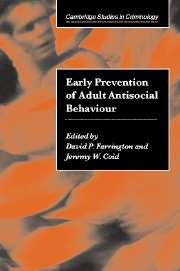Book contents
- Frontmatter
- Contents
- List of figures
- List of tables
- List of contributors
- Preface
- 1 Advancing knowledge about the early prevention of adult antisocial behaviour
- 2 Formulating strategies for the primary prevention of adult antisocial behaviour: “High risk” or ‘population’ strategies?
- 3 Risk factors for adult antisocial personality
- 4 Preventing the intergenerational continuity of antisocial behaviour: Implications of partner violence
- 5 Protective factors and resilience
- 6 Prevention during pregnancy, infancy and the preschool years
- 7 Prevention through family and parenting programmes
- 8 Prevention in the school years
- 9 Prevention of antisocial behaviour in females
- 10 Economic costs and benefits of primary prevention of delinquency and later offending: A review of the research
- 11 Conclusions and the way forward
- Index
- References
10 - Economic costs and benefits of primary prevention of delinquency and later offending: A review of the research
Published online by Cambridge University Press: 22 September 2009
- Frontmatter
- Contents
- List of figures
- List of tables
- List of contributors
- Preface
- 1 Advancing knowledge about the early prevention of adult antisocial behaviour
- 2 Formulating strategies for the primary prevention of adult antisocial behaviour: “High risk” or ‘population’ strategies?
- 3 Risk factors for adult antisocial personality
- 4 Preventing the intergenerational continuity of antisocial behaviour: Implications of partner violence
- 5 Protective factors and resilience
- 6 Prevention during pregnancy, infancy and the preschool years
- 7 Prevention through family and parenting programmes
- 8 Prevention in the school years
- 9 Prevention of antisocial behaviour in females
- 10 Economic costs and benefits of primary prevention of delinquency and later offending: A review of the research
- 11 Conclusions and the way forward
- Index
- References
Summary
Introduction
In recent years, in the United Kingdom and other industrialised countries, there has been a growing interest on the part of governments and other stakeholders in the economic costs and benefits of the early prevention of antisocial behaviour. Rising criminal justice costs, a greater understanding of the economic impacts of crime and fiscal cut-backs are just some of the issues that have prompted this attention. However, investments in effective delinquency and criminality prevention programmes have not kept pace with this level of interest, and investments remain extremely small in comparison with government spending on criminal justice strategies (Waller and Welsh, 1999). This chapter provides some evidence for moving beyond this passive interest.
This chapter is concerned with the primary prevention of delinquency and later offending. Primary prevention focuses on preventing these behaviours before any signs of them become evident. Essentially, it aims to influence positively the early risk factors or ‘root causes’ of delinquency and later offending, typically through broad-based strategies. Some of the major causes or risk factors include: growing up in poverty, living in poor housing, inadequate parental supervision and harsh or inconsistent discipline, parental conflict and separation, low intelligence and poor school performance, and a high level of impulsiveness and hyperactivity (Farrington, 1996). Secondary prevention, which is given some mention here, is distinguished from primary prevention through its targetted interventions at older children and adolescents who show signs of antisocial behaviour or other related risk factors (e.g. substance abuse, delinquent peers).
- Type
- Chapter
- Information
- Early Prevention of Adult Antisocial Behaviour , pp. 318 - 355Publisher: Cambridge University PressPrint publication year: 2003
References
- 4
- Cited by



